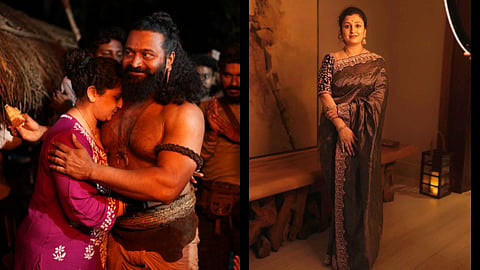

When Kantara (2022) stormed into cinema history, audiences marvelled at its authenticity—every frame felt lived in. But behind that textured world stood someone who rarely steps into the limelight: Pragathi Shetty, the film’s costume designer, creative partner and the wife of director Rishab Shetty. Now, with Kantara Chapter 1, Hombale Films’ biggest project to date, Pragathi steps onto the grandest stage of her career, shaping a visual universe that stretches back a thousand years.
“I have always seen fashion designing as passion, not livelihood. I wanted to breathe every costume I designed,” Pragathi says, her voice carrying the exhilaration of someone who has lived with a project for years. “I didn’t think of the scale, I only thought, what is the best I can give? This film tested me physically, emotionally, and mentally, but it also made me stronger.”
Pragathi honed her instincts with films like Bell Bottom and 777 Charlie, before truly finding notice with Kantara. “That was just a baby step,” she recalls. “Back then, I couldn’t even be on the sets regularly since I was expecting my child. I handled the costumes, but missed that on-ground experience. This time, I didn’t miss a single day. I was present throughout the 250 days of shooting. That presence gave me another level of connection.”
Trust was integral, and Rishab insisted she be part of narrations, discussions, and late-night brainstorming. “He always sees me as a critic. He would say, 'I listen like an audience' and expect me to say what works. That way I could understand the world he wanted to build, and translate that into costumes that felt alive.”
The challenge of Kantara Chapter 1 went far beyond tailoring fabric. The story stretches back nearly a millennium, to an era with little tangible reference.
“We spent more than six months on research, as there were no direct references. We had to look at paintings, sculptures, dance forms, jewellery traditions, even hair accessories. But we couldn’t lift anything as it was, we had to create something original. I always told myself, if anyone looks at our costumes years later, these should become the reference point.”
Colours became her obsession. “Every character had variations depending on the stage of their life. From silhouettes to patterns, every shade was deliberate. Rishab and I worked very closely on this, and every department complemented each other—cinematography, art, costumes. We understood we were building one world.”
The numbers are staggering: more than 1,000 costumes created, three distinct worlds designed—the tribal universe, the royal kingdom, and a landscape of sports and travel. Materials were sourced from across India: silks from the South, leather from Rajasthan, metals from Bengal, dyes steeped in tradition.
“At one point, I realised I didn’t need to be in Bengaluru. We shifted base to Kundapura. Sitting there, I could source materials from across India, my network became my strength. It was stressful, yes, but also exciting," says Pragathi, who points out that none of the costumes were readymade. “Everything had to be customised. Every stitch, every drape, had to have my final approval. We had an in-house team, but also outsourced when needed. Whether it was the leads or junior artistes, everyone’s costume passed through my table.”
Unlike many designers who focus only on principal characters, Pragathi worked on everything, including peripheral roles. “It wasn’t about hierarchy, it was about passion. Real locations, shifting schedules, armours, leather, natural dyes—each day was a learning curve.”
One of the toughest hurdles came with armour. “We had metal tribal costumes, palace leather armour, massive pieces. And I wouldn’t let go until they sat perfectly. Since we were shooting in live locations, we couldn’t keep these anywhere near the sets as it might catch attention. It was tough, but it taught me so much. Honestly, this film has been like a classroom—every day I learned something new.”
What made it possible, she says, was the comfort zone of a core team: actor-director Rishab Shetty, cinematographer Aravind Kashyap, the art department, and herself. “We discussed everything. It wasn’t just designing costumes. I was there from the first line of Kantara, when Rishab cracked the idea five years ago. To live through that process and now see it take form, it’s overwhelming.”
For Pragathi, the journey is deeply personal. “This project gave me a pan-India touch. I got to work with materials and artisans from every corner of the country, and Rishab would often say, this itself is Pan India. But more than that, I feel a kind of protection, a divine blessing. We met impossible deadlines, and still, everything aligned. It’s hard work, yes, but also something beyond us.”
And through it all, Rishab was her anchor. “He is my biggest inspiration. Whenever I doubted myself, I thought, if he can do this, why can’t I? That example was always there. Ours is not just a marriage, it’s a creative partnership. He would discuss changes, sometimes accept my suggestions, sometimes not, but he always valued my perspective. We have always been each other’s moral support.”
As Kantara Chapter 1 readies for its October 2 release, Pragathi allows herself a moment of reflection. “From Kantara to now, I feel pride, gratitude, and joy. More than anything, I feel blessed to have been part of every step. And I’m glad we are part of his dream.”